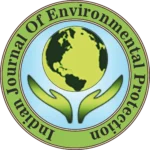IJEP 44(10): 947-960 : Vol. 44 Issue. 10 (October 2024)
Smita Rashmi* and Ravish Kumar
National Institute of Technology, Department of Architecture, Patna – 800 005, Bihar, India
Abstract
This paper is devoted to assessing and analyzing the real-time existing conditions of multi-storied housing buildings (business as usual scenario) in Noida. The paper has tried to analyze the structural conditions, impact of temperature, humidity, moisture, pollution levels and the gases present in the air on the inside and on the building itself. The analysis of existing conditions of a multi-storied housing is done through field inspection and the defects with structural conditions are identified through non-destructive tests (NDT tests), real-time monitoring of indoor air quality and thermal comfort through the adaptive model with temperature, humidity, globe temperature, through sensors and the some of the factors are analyzed through the fundamentals of building physics. Some suggestions for retrofitting are supported with calculations based on mathematical equations. The novelty lies in taking-up integrated condition assessment through real-time continuous monitoring data and assessment as a whole so as to get the real existing condition of the housing in Noida. It was found that changes in environmental conditions and pollution factors are deteriorating the conditions both outside and inside of the building, which is integrated with the performance of the building.
Keywords
Condition assessment, Non-destructive tests, Indian model for adaptive comfort, Tropical summer index, Optimum insulation thickness, Infiltration rates
References
- BEE. 2021. Energy efficiency. In Eco Niwas Samhita. Bureau of Energy Efficiency, Ministry of Power, Government of India, New Delhi.
- BEE. 2014. Design guidelines for energy-efficient multi-storey buidings in India. Bureau of Energy Efficiency, Ministry of Power, Government of India, New Delhi.
- Bhatt, M.S., et al. 2005. Commercial and residential building energy labeling. J. Sci. Ind. Res., 64(1): 30–34.
- BEE. 2014. Handbook of replicable design for energy efficient residential buildings. Bureau of Energy Efficiency, Ministry of Power, Government of India, New Delhi.
- Moncmanová, A. 2007. Environmental factors that influence the deterioration of materials. Env. Deterioration Mater., 28: 1–25.
- Ahmad, S. I., et al. 2017. Water permeability characteristics of normal strength concrete made from crushed clay bricks as coarse aggregate. Adv. Mater. Sci. Eng., 2017(4): 1-9.
- Scharifi, E., et al. 2019. Influence of plastic deformation gradients at room temperature on precipitation kinetics and mechanical properties of high- strength aluminum alloys. J. Eng. Res. Application. 9(1): 24–29.
- IS 13311. 1992. Non-destructive testing of concrete-methods of test. Part 2: Rebound hammer. Bureau of Indian Standards, New Delhi.
- IS 13311. 1992. Method of non-destructive testing of concrete. Part 1: Ultrasonic pulse velocity. Bureau of Indian Standards, New Delhi.
- Yang, Y., et al. 2017. Effects of building design elements on residential thermal environment. Sustain. (Switzerland). 10(1): 1–15.
- SP 41. 1987. Handbook on functional requirements of buildings (other than industrial buildings). Bureau of Indian Standards, New Delhi.
- CPCB. 2018. Ambient air quality data of Delhi stations. Central Pollution Control Board, New Delhli.
- Giao, N.T. and T.V. Phu. 2023. Assessment of spatial and temporal variation of air quality in Ben Tre province, Vietnam. Indian J. Env. Prot., 43(9): 771-782.
- Sathya, J., et al. 2023. Comparative analysis of noise and air pollution in India. Indian J. Env. Prot., 43(9): 799-806.
- Gupta, D., et al. 2021. Natural ventilation design: Predicted and measured performance of a hostel building in composite climate of India. Energy Built Env., 2(1): 82–93.
- Dombaycý, O.A., et al. 2006. Optimization of insulation thickness for external walls using different energy sources. Appl. Energy. 83: 921-928.
- Shanmuga, S. and A. Bhaskaran. 2013. Optimum insulation thickness of walls for energy-saving in hot regions of India. Int. J. Sustain. Energy.33(1): 213–226.
- Goyal, J., et al. 2019. Envelop insulation for energy efficient smart buildings in India. Int. J. Innov. Tech. Exploring Eng., 8(11S): 429–434.
- Shanmuga, P.S. and J. Migdalska. 2015. Cooling degree day analysis as a climate impact indicator for different locations of Poland and India. Int. J. Adv. Sci. Eng. Tech., 3(4): 43-51.
- CLEAR. 2004. Cavities and air spaces. In Comfortable low energy architecture.
- ECBC. 2017. Energy conservation building code2017: Envelope for hot and dry climate, India. Bureau of Energy Efficiency, Ministry of Power, Government of India, New Delhi.
- Cheng, X., et al. 2017. Field study of infiltration rate and its influence on indoor air quality in an apartment. Procedia Eng., 205: 3954–3961.
- Quirouette, R. L., et al. 2004. Air pressure and the building envelope. In Home to Canadian.
- Dixit, S. and S. Lohia. 2015. Energy conservation using window glazing in India. Int. J. Adv. Res. Electrical Electronics Instrumentation Eng., 4(11): 8645–8654.
